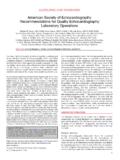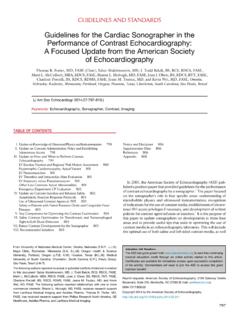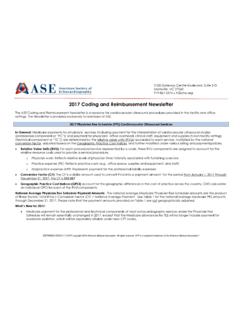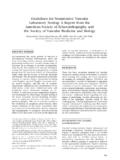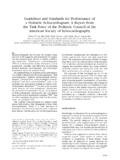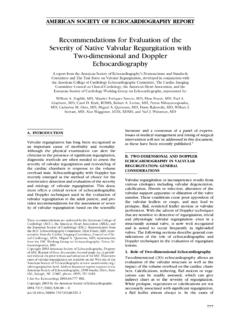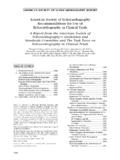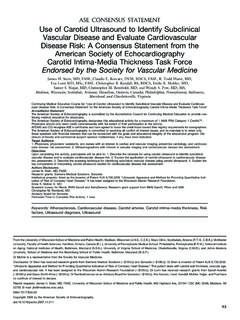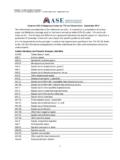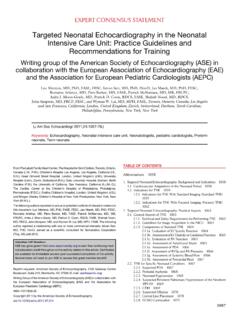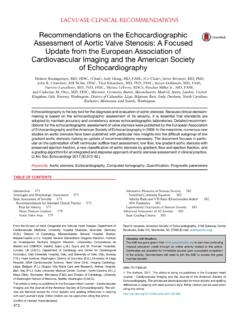Transcription of Echocardiographic Assessment of Valve Stenosis: EAE/ASE ...
1 GUIDELINES AND STANDARDSE chocardiographic Assessment of Valve stenosis : EAE/ASE Recommendations for Clinical PracticeHelmut Baumgartner, MD, Judy Hung, MD, Javier Bermejo, MD, PhD, John B. Chambers, MD, Arturo Evangelista, MD, Brian P. Griffin, MD, Bernard Iung, MD, Catherine M. Otto, MD, Patricia A. Pellikka, MD, and Miguel Qui ones, MD Abbreviations:AR aortic regurgitation, AS aortic stenosis , AVA aortic Valve area,CSA cross sectional area, CWD continuous wave Doppler, D diameter, HOCM hypertrophic obstructive cardiomyopathy, LV left ventricle, LVOT left ventricularoutflow tract, MR mitral regurgitation, MS mitral stenosis , MVA mitral Valve area,DP pressure gradient, RV right ventricle, RVOT right ventricular outflow tract, SV stroke volume, TEE transesophageal echocardiography, T1/2 pressure half-time,TR tricuspid regurgitation, TS tricuspid stenosis , V velocity, VSD ventricularseptal defect, VTI velocity time integralContinuing Medical Education Activity for Echocardiographic Assessment of ValveStenosis: EAE/ASE Recommendations for Clinical Practice Accreditation Statement.
2 The American Society of Echocardiography is accredited by the Accreditation Council forContinuing Medical Education to provide continuing medical education for American Society of Echocardiography designates this educational activity for amaximum of 1 AMA PRA Category 1 Credit . Physicians should only claim creditcommensurate with the extent of their participation in the and CCI recognize ASE s certificates and have agreed to honor the credit hourstoward their registry requirements for American Society of Echocardiography is committed to resolving all conflict of interestissues, and its mandate is to retain only those speakers with financial interests that can bereconciled with the goals and educational integrity of the educational program. Disclosure offaculty and commercial support sponsor relationships, if any, have been Audience:This activity is designed for all cardiovascular physicians, cardiac sonographers andnurses with a primary interest and knowledge base in the field of echocardiography;in addition, residents, researchers, clinicians, sonographers, and other medical pro-fessionals having a specific interest in valvular heart disease may be :Upon completing this activity, participants will be able to: 1.
3 Demonstrate an increasedknowledge of the applications for Echocardiographic Assessment of valvular stenosis and theirimpact on cardiac diagnosis. 2. Differentiate the different methods for echocardiographicassessment of valvular stenosis . 3. Recognize the criteria for Echocardiographic grading ofvalvular stenosis . 4. Identify the advantages and disadvantages of the methodologies em-ployed for assessing valvular stenosis and apply the most appropriate methodology in clinicalsituations 5. Incorporate the Echocardiographic methods of valvular stenosis to form anintegrative approach to Assessment of valvular stenosis 6. Effectively use echocardiographicassessment of valvular stenosis for the diagnosis and therapy for significant valvular Assess the common pitfalls in Echocardiographic Assessment of valvular stenosis andemploy appropriate standards for consistency of valvular stenosis Disclosures:Bernard Iung: Speaker s Fee Edwards Lifesciences, following stated no disclosures: Helmut Baumgartner, Judy Hung, Javier Bermejo,John B.
4 Chambers, Arturo Evangelista, Brian P. Griffin, Catherine M. Otto, Patricia , Miguel Qui of interest: The authors have no conflicts of interest to disclose except as Time to Complete This Activity: 1 hourI. INTRODUCTIONV alve stenosis is a common heart disorder and an important cause ofcardiovascular morbidity and mortality. Echocardiography has be-come the key tool for the diagnosis and evaluation of Valve disease,and is the primary non-invasive imaging method for Valve stenosisassessment. Clinical decision-making is based on echocardiographicassessment of the severity of Valve stenosis , so it is essential thatstandards be adopted to maintain accuracy and consistency acrossechocardiographic laboratories when assessing and reporting valvestenosis. The aim of this paper was to detail the recommendedapproach to the Echocardiographic evaluation of Valve stenosis ,including recommendations for specific measures of stenosis severity,details of data acquisition and measurement, and grading of recommendations are based on the scientific literature and onthe consensus of a panel of document discusses a number of proposed methods forevaluation of stenosis severity.
5 On the basis of a comprehensiveliterature review and expert consensus, these methods were catego-rized for clinical practice as: Level 1 Recommendation: an appropriate and recom-mended method for all patients with stenosis of that Valve . Level 2 Recommendation: a reasonable method for clinicaluse when additional information is needed in selectedpatients. Level 3 Recommendation: a method not recommended forroutine clinical practice although it may be appropriate forresearch applications and in rare clinical is essential in clinical practice to use an integrative approach whenFrom the University of Muenster, Muenster, Germany ( ); Massachusetts General Hospital, Boston, MA, USA ( ); Hospital General Universitario Gregorio Mara n,Barcelona, Spain ( ); Huy s and St. Thomas Hospital, London, United Kingdom ( ); Hospital Vall D Hebron, Barcelona, Spain ( ); Cleveland Clinic, Cleveland,OH, USA ( ); Paris VII Denis Diderot University, Paris, France ( ); University of Washington, Seattle, WA, USA ( ); Mayo Clinic, Rochester, MN, USA ( );and The Methodist Hospital, Houston, TX, USA ( )Reprint requests: American Society of Echocardiography, 2100 Gateway Centre Boulevard, Suite 310, Morrisville, NC Writing Committee of the European Association of Echocardiography (EAE).
6 American Society of Echocardiography (ASE).0894-7317/$ with permission from the European Society of Cardiology. The Author the severity of stenosis , combining all Doppler and 2D data,and not relying on one specific measurement. Loading conditionsinfluence velocity and pressure gradients; therefore, these parametersvary depending on intercurrent illness of patients with low vs. highcardiac output. In addition, irregular rhythms or tachycardia can makeassessment of stenosis severity problematic. Finally, echocardio-graphic measurements of Valve stenosis must be interpreted in theclinical context of the individual patient. The same Doppler echocar-diographic measures of stenosis severity may be clinically importantfor one patient but less significant for AORTIC STENOSISE chocardiography has become the standard means for evaluation ofaortic stenosis (AS) severity.
7 Cardiac catheterization is no longerrecommended1 3except in rare cases when echocardiography isnon-diagnostic or discrepant with clinical guideline details recommendations for recording and mea-surement of AS severity using echocardiography. However, althoughaccurate quantitation of disease severity is an essential step in patientmanagement, clinical decision-making depends on several otherfactors, most importantly symptom status. This echocardiographicstandards document does not make recommendations for clinicalmanagement: these are detailed in the current guidelines for man-agement of adults with valvular heart Causes and Anatomic PresentationThe most common causes of valvular AS are a bicuspid aortic valvewith superimposed calcific changes, calcific stenosis of a trileafletvalve, and rheumatic Valve disease (Figure 1).
8 In Europe and the USA,bicuspid aortic Valve disease accounts for 50% of all Valve replace-ments for of a trileaflet Valve accounts for most ofthe remainder, with a few cases of rheumatic AS. However, world-wide, rheumatic AS is more evaluation of the aortic Valve is based on a combinationof short- and long-axis images to identify the number of leaflets, andto describe leaflet mobility, thickness, and calcification. In addition,the combination of imaging and Doppler allows the determination ofthe level of obstruction; subvalvular, valvular, or supravalvular. Trans-thoracic imaging usually is adequate, although transesophageal echo-cardiography (TEE) may be helpful when image quality is bicuspid Valve most often results from fusion of the right and leftcoronary cusps, resulting in a larger anterior and smaller posteriorcusp with both coronary arteries arising from the anterior cusp( 80% of cases), or fusion of the right and non-coronary cuspsresulting in a larger right than left cusp with one coronary arteryarising from each cusp (about 20% of cases).
9 5,6 Fusion of the left andnon-coronary cusps is rare. Diagnosis is most reliable when the twocusps are seen in systole with only two commissures framing anelliptical systolic orifice. Diastolic images may mimic a tricuspid valvewhen a raphe is present. Long-axis views may show an asymmetricclosure line, systolic doming, or diastolic prolapse of the cusps butthese findings are less specific than a short-axis systolic image. Inchildren and adolescents, a bicuspid Valve may be stenotic withoutextensive calcification. However, in adults, stenosis of a bicuspidaortic Valve typically is due to superimposed calcific changes, whichoften obscures the number of cusps, making determination of bicus-pid vs. tricuspid Valve of a tricuspid aortic Valve is most prominent when thecentral part of each cusp and commissural fusion is absent, resultingin a stellate-shaped systolic orifice.
10 With calcification of a bicuspid ortricuspid Valve , the severity of Valve calcification can be gradedsemi-quantitatively, as mild (few areas of dense echogenicity withlittle acoustic shadowing), moderate, or severe (extensive thickeningand increased echogenicity with a prominent acoustic shadow). Thedegree of Valve calcification is a predictor of clinical ,7 Rheumatic AS is characterized by commisural fusion, resulting in atriangular systolic orifice, with thickening and calcification mostprominent along the edges of the cusps. Rheumatic disease nearlyalways affects the mitral Valve first, so that rheumatic aortic valvedisease is accompanied by rheumatic mitral Valve changes. Subvalvu-lar or supravalvular stenosis is distinguished from valvular stenosisbased on the site of the increase in velocity seen with colour or pulsedDoppler and on the anatomy of the outflow tract.
